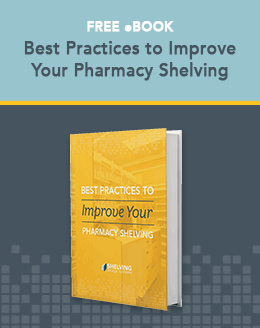 Medicines in your retail pharmacy will generally be sectioned off into two areas—prescription medications in the rear end behind the dispensing counter and OTC medicines out in front where customers can access them directly. Drugs in the back end are stored with an eye toward security and ease of access for technicians and pharmacists making up various prescriptions. Over-the-counter drugs, however, are usually displayed out front in such a way that customers will be easily able to locate them without assistance.
Medicines in your retail pharmacy will generally be sectioned off into two areas—prescription medications in the rear end behind the dispensing counter and OTC medicines out in front where customers can access them directly. Drugs in the back end are stored with an eye toward security and ease of access for technicians and pharmacists making up various prescriptions. Over-the-counter drugs, however, are usually displayed out front in such a way that customers will be easily able to locate them without assistance.
- These OTC displays in a retail pharmacy should be designed in such a way as to be consumer-centric and categorized to offer similar products designed to solve specific complaints. As an example, pain relief products can be grouped together in order to make comparisons between different items easy for customers to make. Similar-looking packaging for different types of products shouldn't be mistakenly grouped together, however, as this can cause some confusion. An example of this is the NyQuil™ Cold & Flu products made by Vicks. There's a wide range of nearly a dozen of these products available, including liquid, LiquiCaps™, caplets, SEVERE formula, Nighttime formula, DayQuil, cough suppressant and more. These items can be shelved together in close proximity to one another but separated into different types. This would all go well into a separate shelving configuration with conspicuous Vicks NyQuil signage.
NyQuil is one of the most predominant brands of cold and flu medications found in a retail pharmacy and is recognized by nearly everyone. However, one of their new products, ZzzQuil™, is packaged similar to the other NyQuil products but isn't a cold and flu remedy at all but, rather, a sleep aid. This item should be placed on a shelf with other sleep aids, not with other NyQuil products, in order to avoid any confusion as to its purpose.
Types of Shelving Best Utilized for OTC Medicines
- Often OTC medicines can be displayed on the store-side of the pharmacy counter, in which case slat wall panels fitted with glass shelves work well. These slat walls also fit well in different locations of your store's perimeter wall, where they can be fitted with shelves, bins, baskets, hooks and other needed attachments. For display in the center area of the merchandising area, new–style gondola shelving is popular and especially useful when fitted with end caps to highlight topical items, such as cold medicines in winter and sunburn relief items in summer. New types of gondola shelves are now available that don't have the traditional straight lines and sharp corners. Serpentine models, for example, can be used to provide customers with a different visual perspective. These lighter-weight gondolas are also easier than ever to move, making the relocation of certain displays quick and simple.
- Grouping complimentary items together on the same shelf or display platform can work well in boosting sales. Some examples are placing pain relief medicines next to sunburn relief formulas or products to relieve joint pain or sore muscles next to hand, wrist and ankle wraps or braces. Placing certain OTC medicines strategically on floor or counter point-of-purchase displays can also allow customers to buy things they need but might otherwise have forgotten to pick up such as Band-Aids, aspirin or throat lozenges.
OTC medications will often be purchased by your customers if mentioned to them by the pharmacist or other staff members. It's important to know what you have in stock and where in the store it's located. Having these things well-displayed and easy to see and reach should definitely help with sales.




